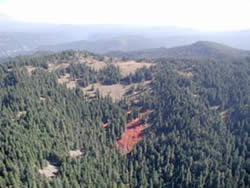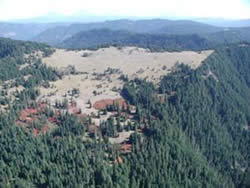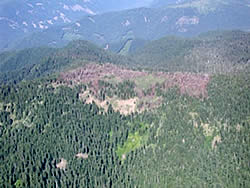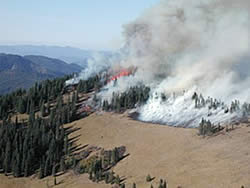
National Fire Plan Success Story
Chucksney and Grasshopper Meadows Restoration Project
McKenzie River and Middle Fork Ranger Districts,
Willamette National Forest, Oregon
National Fire Plan - Rehabilitation
2009

Chucksney Meadow.

Grasshopper Meadow.

Chucksney Meadow Post-burn.

Grasshopper Prescribed Burn.
Chucksney and Grasshopper meadows are high elevation grasslands located along a ridgeline, between two mountains, by the same names on the Willamette National Forest. The meadows are refugia for plants and animals because of low road access and relatively low human use. They are important for cross pollination of plants and provide a gene pool for uncommon meadow species. Over the past several decades, extensive encroachment by conifer trees has reduced these meadows to almost half of their historical size.
Projects to restore Chucksney and Grasshopper meadows were implemented in 1980 and 1994. In 2006, a decision memo was signed to continue meadow restoration. Project activities began with removal of barbed wire fencing followed by cutting and girdling of small diameter conifers (less than 10-inches diameter) within designated meadow boundaries. In September, 2007, a total of 190 acres were burned within the two meadows and followed by reseeding with native grasses.
As a result of this project, forage for big game should improve. Meadow rodents should also thrive providing increased prey for predators such as great gray owl and American kestrel. Trees within meadows that were killed by burning should provide snag habitat benefiting woodpeckers, bats, and small mammals that rely on cavities in trees. The project will reintroduce fire into this ecosystem where it served naturally to maintain meadows that also provide an important, unique and aesthetic hiking and hunting experience.
The success of this project is attributed to the collaboration and partnerships of the Rocky Mountain Elk Foundation, Oregon Hunter’s Association, Grand Ronde Tribes, and the Willamette National Forest.
For more information contact, Mei Lin Lantz, mlantz@fs.fed.us, (541) 822-7250.